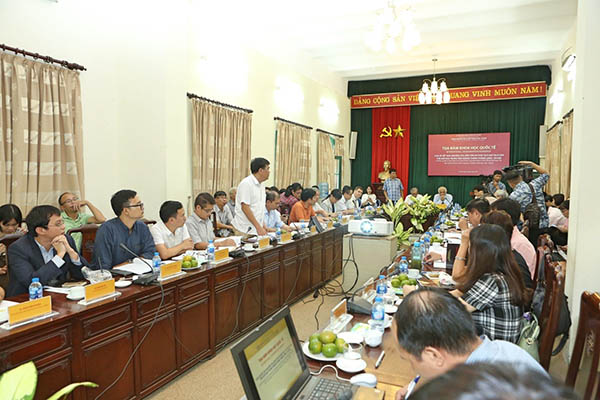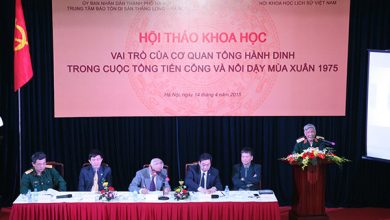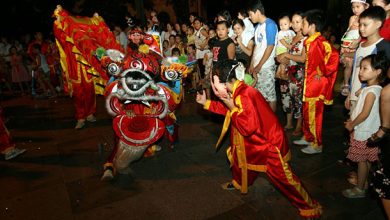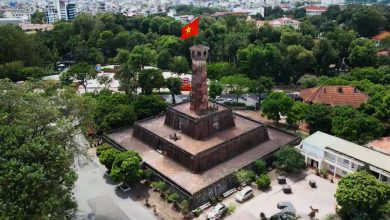International Dissemination Workshop “Further results in the research, conservation and promotion of the World Heritage Site of Thăng Long Imperial Citadel”
On 6 September 2018, the Thăng Long – Hà Nội Heritage Conservation Centre organized the International Dissemination Workshop “Further results in the research, conservation and promotion of the World Heritage Site of Thăng Long Imperial Citadel”. The event was attended by Vietnamese and foreign scientists who have been working closely on Thăng Long Imperial Citadel for many years.

Discussion at the workshop
The Central Sector of the Imperial Citadel of Thăng Long – Hà Nội was inscribed by UNESCO on the List of World Heritage in 2010. The site boasts a history of more than 1000 years, with multiple diverse cultural layers.
Eight years after UNESCO’s recognition, there has been significant progress in the research of Thăng Long, especially archaeological excavation which sheds more light on the cultural, historical, and architectural values of Thăng Long – Hà Nội, many of which remain underground.
The results shared in the international dissemination workshop this time are expected to help expand international cooperation in the research, conservation and promotion of the heritage value with interdisciplinary and multidisciplinary approach and identify research orientation for the coming periods.
The organizing committee received 11 papers on three major areas of the workshop, namely results of archaeological research at 18 Hoàng Diệu, results of conservation of artefacts/relics, and results of heritage value promotion activities. The participants at the workshop also offered a number of scientific explanations with regard to the identification of the overall layout and plan of palace structures in the central part of the Forbidden Citadel and the main palace of Kính Thiên. These are the results of their academic endeavor over the past years.
According to Assoc.Prof. Tống Trung Tín, President of the Vietnam Archaeologist’s Association, after seven years of increased archaeological excavations at the recommendation of UNESCO, especially the one conducted right at site of the Kính Thiên Palace, the Centre has obtained positive results that gradually lead to improved understanding of the vestiges of the structures in the royal palaces of Thăng Long in the past, identify the consecutive and overlapping cultural layers from the Lý, Trần, Lê, Nguyễn dynasties that are similar to those revealed in 18 Hoàng Diệu. Most noteworthy is the discovery of vestiges of a substantial water channel of the Lý dynasty in this area, as well as the partial identification of the space of the Kính Thiên main palace of the Lê sơ (Early Lê) and Lê Trung hưng (Restored Lê) including the royal path, the royal yard of Đan Trì, together with the surrounding corridor. However, as the area of excavation is not yet large enough to have an accurate identification of the whole space, the scope and structure of the layout of the main palace of Kính Thiên remain incompletely understood.
Dr. Bùi Văn Liêm from Vietnam Institute of Archaeology suggested that archaeological research findings in the past years have contributed to an improved understanding of the Lý – Trần period in the Kính Thiên Palace, particularly a better understanding of the Lê sơ and Lê Trung hưng periods with important architectural vestiges of structures that were both massive and well-planned. However, as geological strata are very important in archaeological research, it is necessary to clarify the overlapping and consecutive cultural layers and even the most underneath layer of the Đại La period.

Representative of the Delegation of Wallonie, Bruxelles (Belgium) addressing the workshop
Assoc.Prof. Bùi Minh Trí from the Institute of Citadel Research also raised a number of questions that require further research to be satisfactorily answered. Examples include where the central axis of the Forbidden Citadel of Thăng Long was, whether Thăng Long Imperial Citadel had more than one central axis, how the main and subsidiary axes could be identified, or the need to link one structure to proximal structures and the overall space of the area.
In the second part of the workshop, which was related to the conservation of artefacts and relics, a team from the Vietnamese Academy of Forest Sciences presented a research on the use of an eco-friendly material called Feather Keratin in the preservation of wooden artefacts at Thăng Long Imperial Citadel. Some results in the cooperation between the Thăng Long-Hà Nội Heritage Conservation Centre and colleagues from Belgium in the environmental assessment of the 18 Hoàng Diệu Site were also briefed. Recommendations were made, as a result, to limit environmental impacts on relics, such as by increasing soil moisture, and keeping moisture of the surface the relics stable at over 35% and below 70%, minimizing direct sunlight contact and maintaining stable light. Chemicals to constrain the development of mould, moss and plants should be piloted while manual conservation methods avoided so as not to damage the relics and artefacts.
In the third part of the workshop, which is on heritage promotion, the papers presented results that have been achieved in the promotion of the heritage values, especially in exhibitions, displays, and heritage education activities. Among these, education and visibility programmes, which bring heritage closer to schools and young generations, have been lauded as highlights.
In relation to this issue, Assoc.Prof. Đặng Văn Bài from Vietnam Cultural Heritage Association, believing that heritage education, community education is an important component in heritage conservation, concurred with the current approach adopted by the Centre to heritage education in which teaching is linked to inquiry and takes place through experience and interaction, allowing students to take ownership of their learning process through heritage exploration.
Addressing the workshop, Mr. Trần Thành, Deputy Director-General of the Department of Cultural Heritage requested that the Centre, apart from archaeological excavation research, pay attention to other tasks such as the documentation of archaeological literature and develop fundamental research orientations so that results can be more tangible. At the same time, more investment should be made in long-term conservation of archaeological relics.
In his summary of the workshop, Prof.Dr. Lưu Trần Tiêu, President of the National Council on Cultural Heritage said that the Centre needs to continue archaeological research to identify the central axis of the Lý -Trần and find more satisfactory answers to issues that remain controversial. It is also necessary to expand international and interdisciplinary cooperation in research, further excavate the Kính Thiên Palace area to serve the need for potential restoration of this palace, consult literature on octagonal structures of East Asian countries and refer to the realities of excavation at 18 Hoàng Diệu in order to arrive at a grounded identification of the central axis of the citadel under the Lý-Trần. In addition, it is necessary to test carefully eco-friendly materials before official use on relics and artefacts at Thăng Long Imperial Citadel and continue attempts to preserve wooden objects against the current climatic conditions and develop a long-term plan for the conservation of the heritage site.
Kim YếnThăng Long – Hà Nội Heritage Conservation Centre





